warning light TOYOTA TACOMA 2010 Owners Manual (in English)
[x] Cancel search | Manufacturer: TOYOTA, Model Year: 2010, Model line: TACOMA, Model: TOYOTA TACOMA 2010Pages: 532, PDF Size: 15.03 MB
Page 2 of 532

TABLE OF CONTENTSIndex
2
1-1. Key information
Keys ..................................... 30
1-2. Opening, closing and locking
the doors
Wireless remote control ....... 32
Side doors ............................ 35
Access doors (Access Cab
models only) ....................... 39
Tailgate ................................ 40
1-3. Adjustable components
(seats, mirrors, steering
wheel)
Front seats ........................... 45
Rear seats (Access Cab
and Double Cab models) ... 50
Head restraints ..................... 54
Seat belts ............................. 58
Steering wheel ..................... 64
Anti-glare inside rear view
mirror .................................. 65
Outside rear view mirrors ..... 68
1-4. Opening and closing the
windows
Power windows .................... 71
Back window (vehicles
with sliding type)................. 73
1-5. Refueling
Opening the fuel tank cap .... 741-6. Theft deterrent system
Engine immobilizer system ... 78
1-7. Safety information
Correct driving posture ......... 81
SRS airbags ......................... 83
Front passenger occupant
classification system ......... 100
Child restraint systems ....... 107
Installing child restraints ..... 112
2-1. Driving procedures
Driving the vehicle .............. 134
Engine (ignition) switch....... 144
Automatic
Transmission...... 147
Manual Transmission ......... 150
Turn signal lever ................. 153
Parking brake ..................... 154
Horn .................................... 156
2-2. Gauges and meters
Gauges and meters ............ 157
Indicators and warning
lights ................................. 160
Accessory meter ................. 163
2-3. Operating the lights and
wipers
Headlight switch ................. 164
Fog light switch ................... 166
Windshield wipers and
washer .............................. 167
1Before driving
2When driving
Page 5 of 532

1
2
3
4
5
6
7
5
5-2. Steps to take in an emergency
If a warning light turns on
or a warning buzzer
sounds... ........................... 431
If you have a flat tire............ 440
If the engine will not start .... 456
If the shift lever cannot be
shifted from P.................... 457
If you lose your keys ........... 458
If the vehicle battery is
discharged ........................ 459
If your vehicle overheats ..... 463
If the vehicle becomes
stuck ................................. 466
If your vehicle has to be
stopped in an
emergency ........................ 468
6-1. Specifications
Maintenance data
(fuel, oil level, etc.) ............ 470
Fuel information .................. 488
Tire information ................... 491
6-2. Customization
Customizable features ........ 502
Items to initialize ................. 503Reporting safety defects
for U.S. owners ................ 506
Seat belt instructions for
Canadian owners
(in French) ........................ 507
Camper information ............ 509
Abbreviation list ........................ 516
Alphabetical index .................... 518
What to do if... ........................... 527
6Vehicle specifications
7For owners
Index
Page 62 of 532
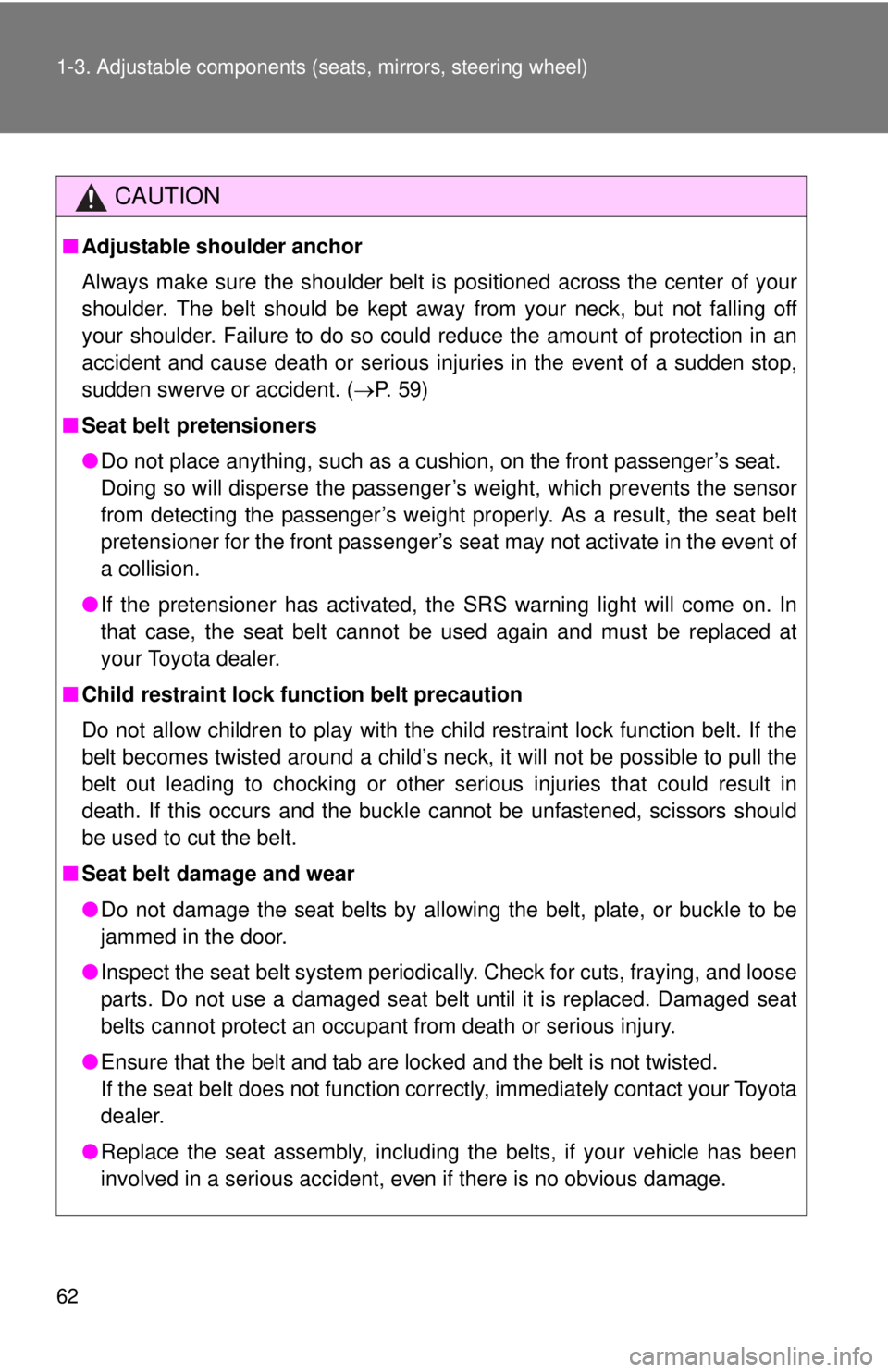
62 1-3. Adjustable components (seats, mirrors, steering wheel)
CAUTION
■Adjustable shoulder anchor
Always make sure the shoulder belt is positioned across the center of your
shoulder. The belt should be kept away from your neck, but not falling off
your shoulder. Failure to do so could reduce the amount of protection in an
accident and cause death or serious injuries in the event of a sudden stop,
sudden swerve or accident. (P. 59)
■Seat belt pretensioners
●Do not place anything, such as a cushion, on the front passenger’s seat.
Doing so will disperse the passenger’s weight, which prevents the sensor
from detecting the passenger’s weight properly. As a result, the seat belt
pretensioner for the front passenger’s seat may not activate in the event of
a collision.
●If the pretensioner has activated, the SRS warning light will come on. In
that case, the seat belt cannot be used again and must be replaced at
your Toyota dealer.
■Child restraint lock function belt precaution
Do not allow children to play with the child restraint lock function belt. If the
belt becomes twisted around a child’s neck, it will not be possible to pull the
belt out leading to chocking or other serious injuries that could result in
death. If this occurs and the buckle cannot be unfastened, scissors should
be used to cut the belt.
■Seat belt damage and wear
●Do not damage the seat belts by allowing the belt, plate, or buckle to be
jammed in the door.
●Inspect the seat belt system periodically. Check for cuts, fraying, and loose
parts. Do not use a damaged seat belt until it is replaced. Damaged seat
belts cannot protect an occupant from death or serious injury.
●Ensure that the belt and tab are locked and the belt is not twisted.
If the seat belt does not function correctly, immediately contact your Toyota
dealer.
●Replace the seat assembly, including the belts, if your vehicle has been
involved in a serious accident, even if there is no obvious damage.
Page 85 of 532
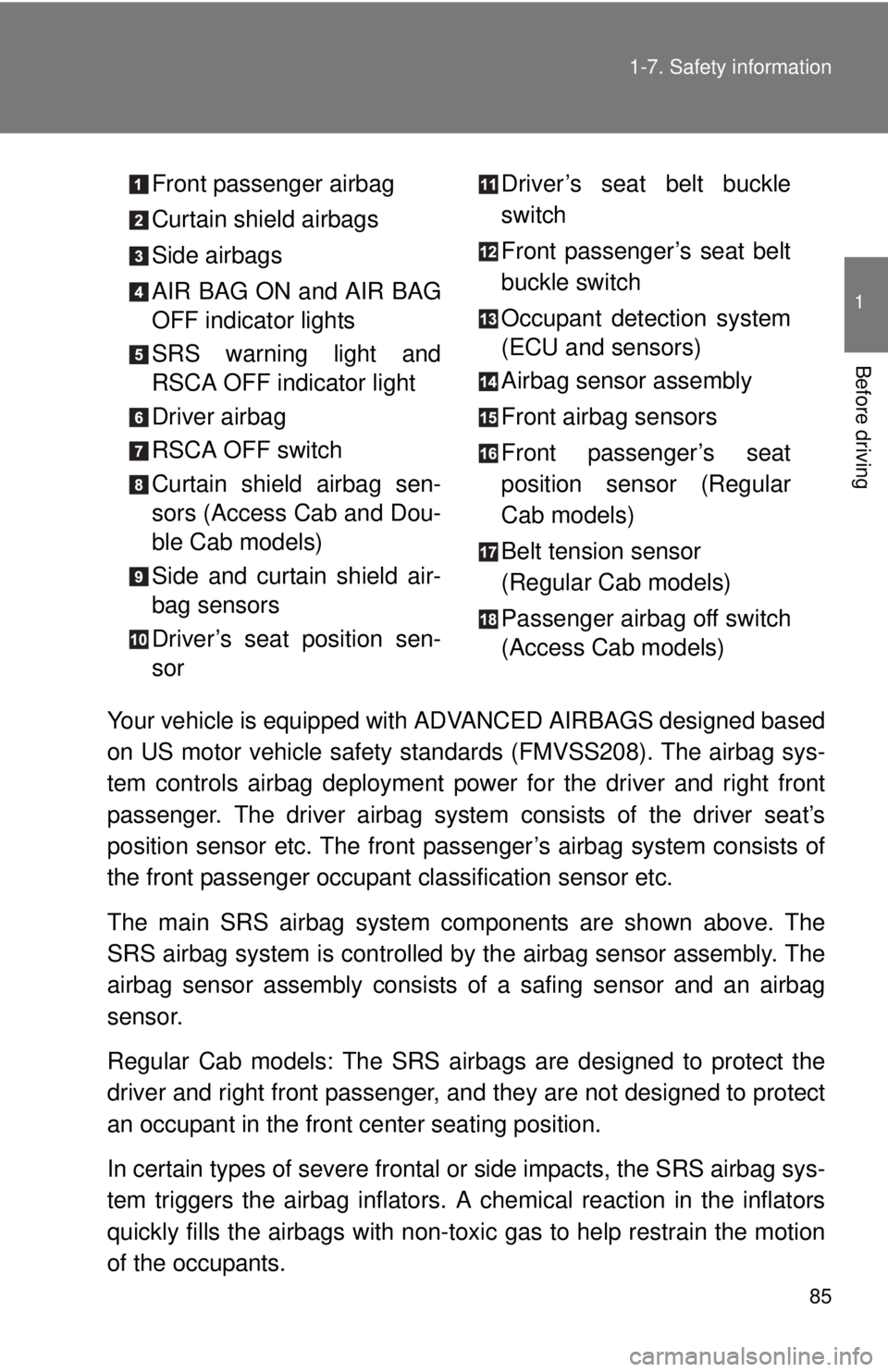
85 1-7. Safety information
1
Before driving
Your vehicle is equipped with ADVANCED AIRBAGS designed based
on US motor vehicle safety standards (FMVSS208). The airbag sys-
tem controls airbag deployment power for the driver and right front
passenger. The driver airbag system consists of the driver seat’s
position sensor etc. The front passenger’s airbag system consists of
the front passenger occupant classification sensor etc.
The main SRS airbag system components are shown above. The
SRS airbag system is controlled by the airbag sensor assembly. The
airbag sensor assembly consists of a safing sensor and an airbag
sensor.
Regular Cab models: The SRS airbags are designed to protect the
driver and right front passenger, and they are not designed to protect
an occupant in the front center seating position.
In certain types of severe frontal or side impacts, the SRS airbag sys-
tem triggers the airbag inflators. A chemical reaction in the inflators
quickly fills the airbags with non-toxic gas to help restrain the motion
of the occupants. Front passenger airbag
Curtain shield airbags
Side airbags
AIR BAG ON and AIR BAG
OFF indicator lights
SRS warning light and
RSCA OFF indicator light
Driver airbag
RSCA OFF switch
Curtain shield airbag sen-
sors (Access Cab and Dou-
ble Cab models)
Side and curtain shield air-
bag sensors
Driver’s seat position sen-
sorDriver’s seat belt buckle
switch
Front passenger’s seat belt
buckle switch
Occupant detection system
(ECU and sensors)
Airbag sensor assembly
Front airbag sensors
Front passenger’s seat
position sensor (Regular
Cab models)
Belt tension sensor
(Regular Cab models)
Passenger airbag off switch
(Access Cab models)
Page 86 of 532

86 1-7. Safety information
■SRS warning light
This warning light system monitors the airbag sensor assembly, front airbag
sensors, side and curtain shield airbag sensor assemblies, curtain shield air-
bag sensor assemblies (Access Cab and Double cab models), driver’s seat
position sensor, driver’s seat belt buckle switch, front passenger occupant
classification system, AIR BAG ON and AIR BAG OFF indicator lights, front
passenger’s seat position sensor (Regular Cab models), front passenger’s
seat belt buckle switch, passenger airbag off switch (Access Cab models),
front seat belt pretensioner assemblies, belt tension sensor (Regular Cab
models), RSCA OFF indicator light, inflators, interconnecting wiring and
power sources. (P. 432)
■If the SRS airbags deploy (inflate)
●Bruising and slight abrasions may result from contact with a deploying
(inflating) SRS airbag.
●A loud noise and white powder will be emitted.
●Parts of the airbag module (steering wheel hub, airbag cover and inflator)
as well as the front seats, and parts of the front and rear pillars and roof
side rail, may be hot for several minutes. The airbag itself may also be
hot.
●The front windshield may crack.
■Operating conditions (front airbags)
●The SRS front airbags will deploy in the event of an impact that exceeds
the set threshold level (the level of force corresponding to an approxi-
mately 12-18 mph [20-30 km/h] frontal collision with a fixed wall that does
not move or deform).
However, this threshold velocity will be considerably higher if the vehicle
strikes an object, such as a parked vehicle or sign pole, which can move or
deform on impact, or if the vehicle is involved in an underride collision (e.g.
a collision in which the front of the vehicle “underrides”, or goes under, the
bed of a truck, etc.).
●It is possible that in some collisions where the forward deceleration of the
vehicle is very close to the designed threshold level, the SRS front air-
bags and the seat belt pretensioners may not activate together.
Page 100 of 532
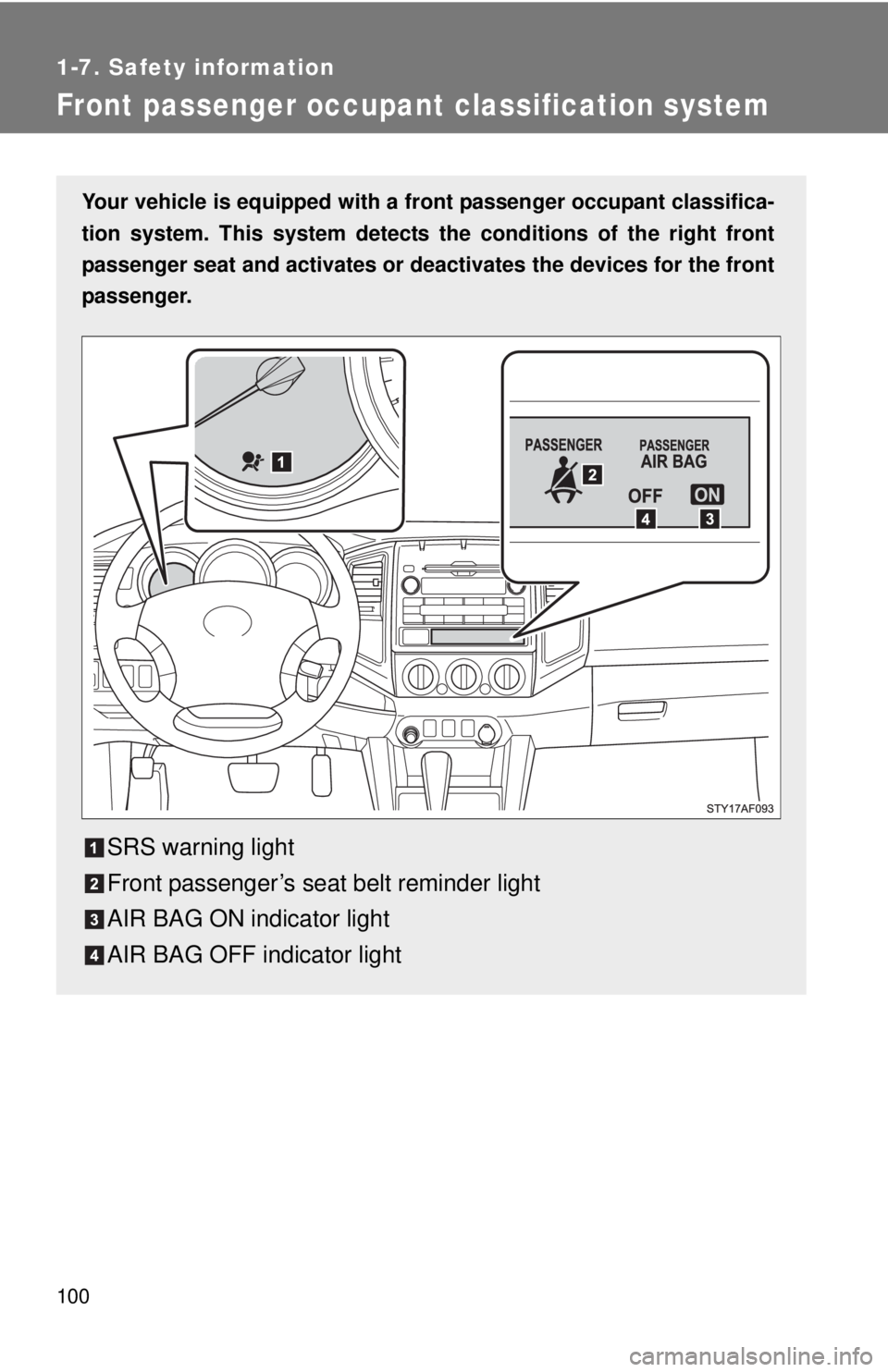
100
1-7. Safety information
Front passenger occupant classification system
Your vehicle is equipped with a front passenger occupant classifica-
tion system. This system detects the conditions of the right front
passenger seat and activates or deactivates the devices for the front
passenger.
SRS warning light
Front passenger’s seat belt reminder light
AIR BAG ON indicator light
AIR BAG OFF indicator light
Page 101 of 532
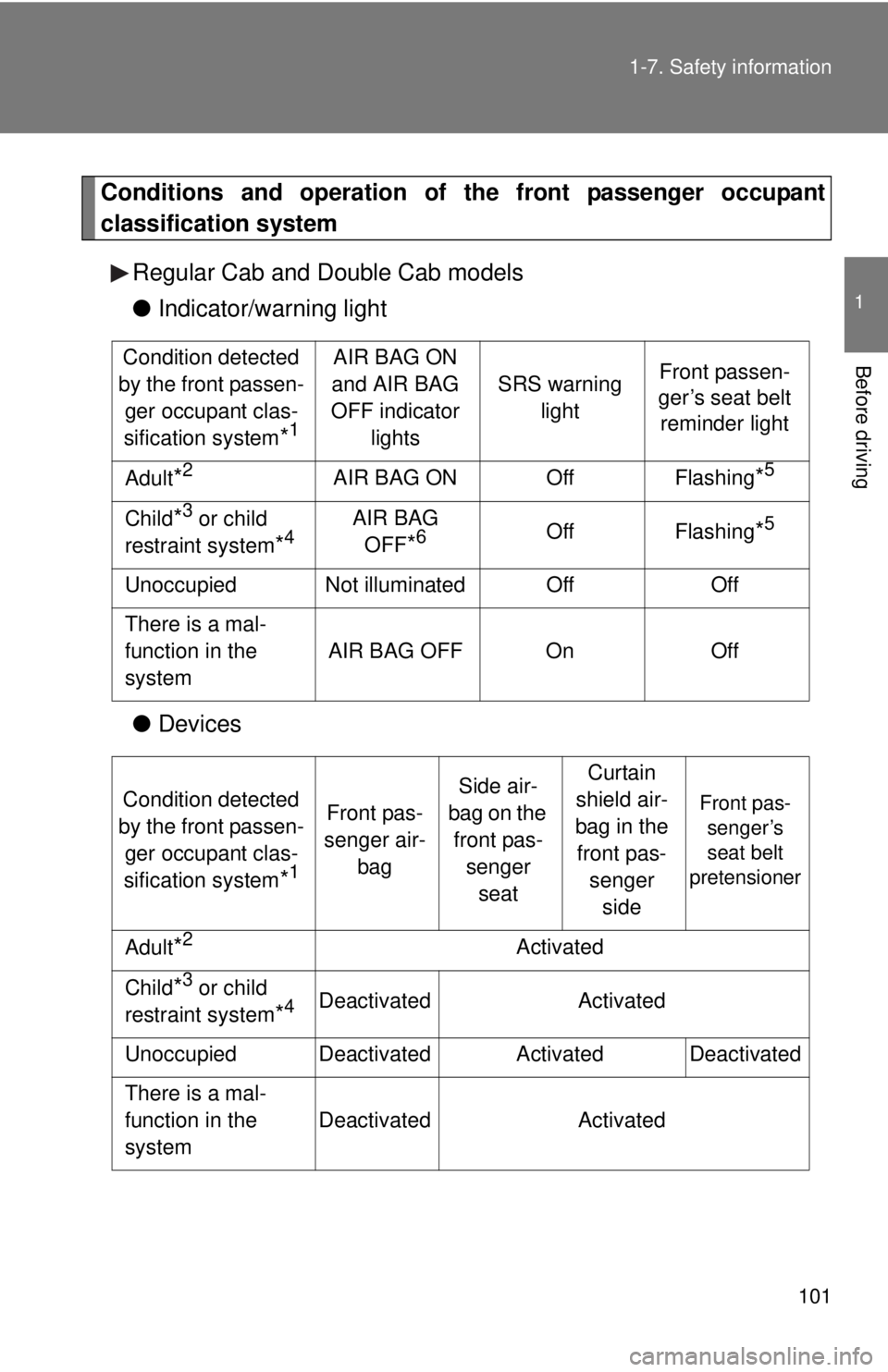
101 1-7. Safety information
1
Before driving
Conditions and operation of the front passenger occupant
classification system
Regular Cab and Double Cab models
●Indicator/warning light
●Devices
Condition detected
by the front passen-
ger occupant clas-
sification system
*1
AIR BAG ON
and AIR BAG
OFF indicator
lights
SRS warning
lightFront passen-
ger’s seat belt
reminder light
Adult*2AIR BAG ONOffFlashing*5
Child*3 or child
restraint system
*4AIR BAG
OFF
*6OffFlashing*5
UnoccupiedNot illuminatedOffOff
There is a mal-
function in the
system
AIR BAG OFFOnOff
Condition detected
by the front passen-
ger occupant clas-
sification system
*1
Front pas-
senger air-
bag
Side air-
bag on the
front pas-
senger
seatCurtain
shield air-
bag in the
front pas-
senger
side
Front pas-
senger’s
seat belt
pretensioner
Adult*2Activated
Child*3 or child
restraint system
*4DeactivatedActivated
UnoccupiedDeactivatedActivatedDeactivated
There is a mal-
function in the
system
DeactivatedActivated
Page 103 of 532
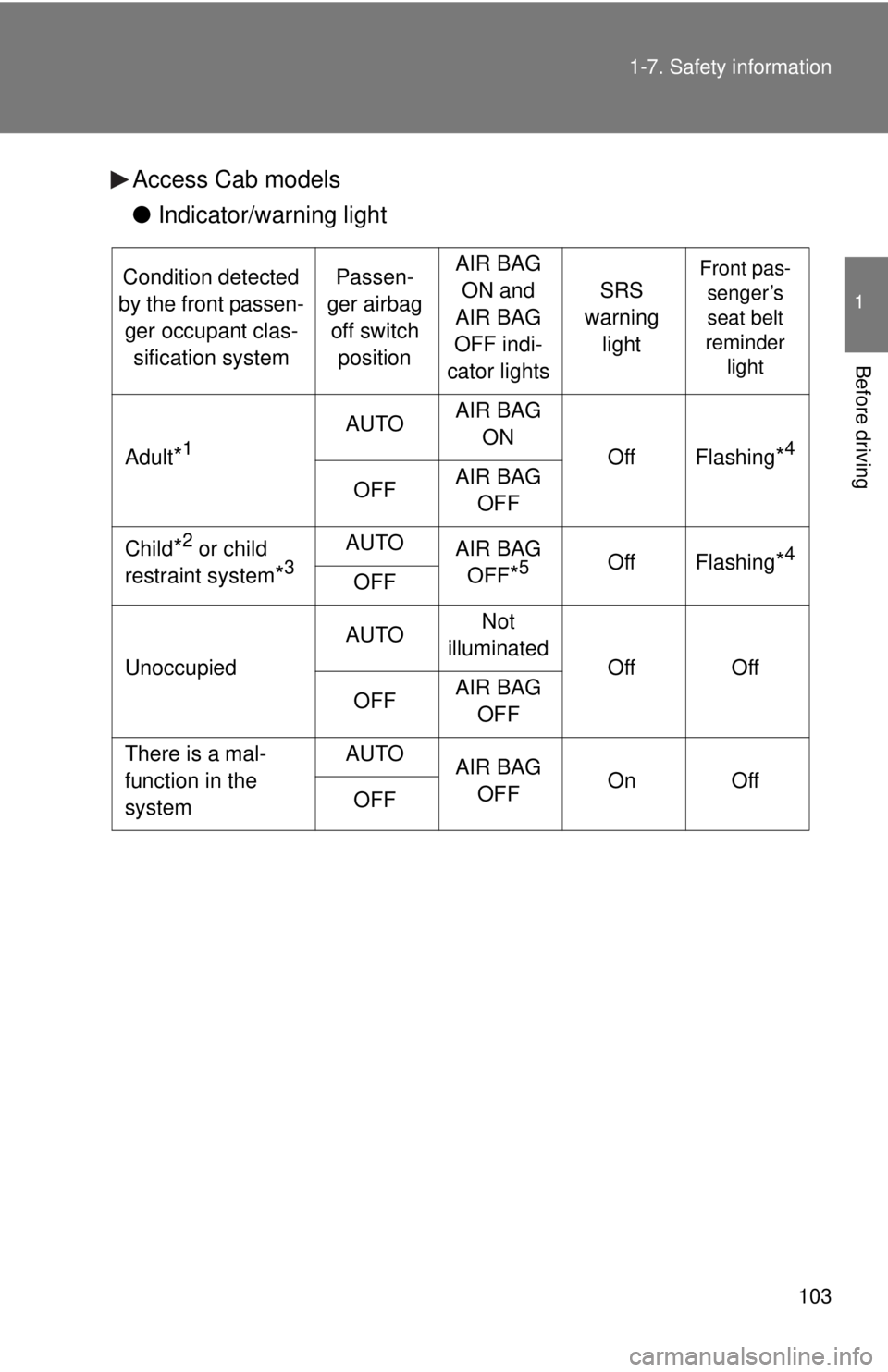
103 1-7. Safety information
1
Before driving
Access Cab models
●Indicator/warning light
Condition detected
by the front passen-
ger occupant clas-
sification systemPassen-
ger airbag
off switch
positionAIR BAG
ON and
AIR BAG
OFF indi-
cator lights
SRS
warning
light
Front pas-
senger’s
seat belt
reminder
light
Adult*1
AUTOAIR BAG
ON
OffFlashing*4
OFFAIR BAG
OFF
Child*2 or child
restraint system
*3
AUTOAIR BAG
OFF
*5OffFlashing*4
OFF
Unoccupied
AUTONot
illuminated
OffOff
OFFAIR BAG
OFF
There is a mal-
function in the
systemAUTOAIR BAG
OFFOnOffOFF
Page 106 of 532

106 1-7. Safety information
CAUTION
■Front passenger occupant classification system precautions
●If an adult sits in the front passenger seat, the AIR BAG ON indicator light
is illuminated. If the AIR BAG OFF indicator is illuminated, ask the passen-
ger to sit up straight, well back in the seat, feet on the floor, and with the
seat belt worn correctly. If the AIR BAG OFF indicator still remains illumi-
nated, either ask the passenger to move to the rear seat, or if that is not
possible, move the front passenger seat fully rearward.
●When it is unavoidable to install the forward-facing child restraint system
on the front passenger seat, install the child restraint system on the front
passenger seat in the proper order. (P. 112)
●Do not modify or remove the front seats.
●Do not kick the front passenger seat or subject it to severe impact. Other-
wise, the SRS warning light may come on to indicate a malfunction of the
detection system. In this case, contact your Toyota dealer immediately.
●Child restraint systems installed on the rear seat should not contact the
front seatbacks.
●Do not use a seat accessory, such as a cushion or seat cover, that covers
the seat cushion surface.
●Access Cab and Double Cab models: Do not attach a commercial seat-
back table or other heavy item to the back of the front passenger seat.
●Do not modify or replace the upholstery of the front seat.
Page 133 of 532
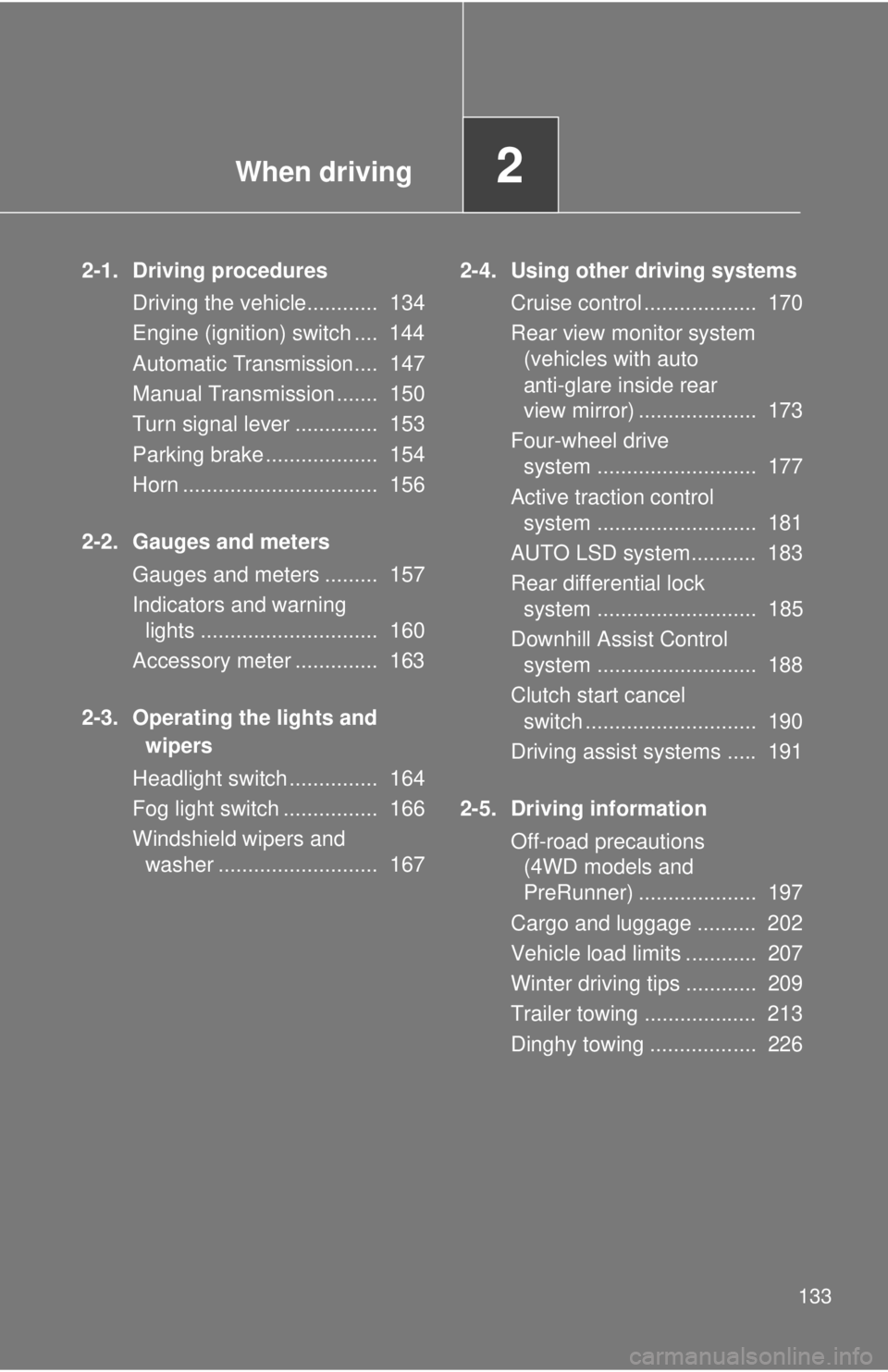
When driving2
133
2-1. Driving procedures
Driving the vehicle............ 134
Engine (ignition) switch .... 144
Automatic
Transmission.... 147
Manual Transmission ....... 150
Turn signal lever .............. 153
Parking brake ................... 154
Horn ................................. 156
2-2. Gauges and meters
Gauges and meters ......... 157
Indicators and warning
lights .............................. 160
Accessory meter .............. 163
2-3. Operating the lights and
wipers
Headlight switch ............... 164
Fog light switch ................ 166
Windshield wipers and
washer ........................... 1672-4. Using other driving systems
Cruise control ................... 170
Rear view monitor system
(vehicles with auto
anti-glare inside rear
view mirror) .................... 173
Four-wheel drive
system ........................... 177
Active traction control
system ........................... 181
AUTO LSD system........... 183
Rear differential lock
system ........................... 185
Downhill Assist Control
system ........................... 188
Clutch start cancel
switch ............................. 190
Driving assist systems ..... 191
2-5. Driving information
Off-road precautions
(4WD models and
PreRunner) .................... 197
Cargo and luggage .......... 202
Vehicle load limits ............ 207
Winter driving tips ............ 209
Trailer towing ................... 213
Dinghy towing .................. 226